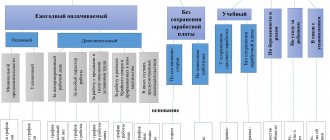General and special rules
In general, an employee who is hired on a fixed-term contract has the same holiday rights as anyone else. But there are two exceptions:
- If the term of the employment contract does not exceed 2 months (Article 291 of the Labor Code of the Russian Federation).
- If the employee is involved in seasonal work (Article 295 of the Labor Code of the Russian Federation).
In these cases, leave is granted at the rate of 2 working days for each month of work .
If both situations are not applicable to a “fixed-term” employee, then he is granted leave on a general basis.
Vacation schedule: when are new employees entitled to vacation?
As you know, the order of granting vacations to employees is determined according to the vacation schedule. It must be drawn up no later than December 17 of the current year for the next calendar year (Article 123 of the Labor Code of the Russian Federation).
If at the end of the year you have an employee who has been working in the organization for less than 6 months, then when creating a schedule, you should plan vacation for him during his first working year. And if it turns out that he has the right to go on vacation before the end of six months of work (as in the case when a husband asks for leave during his wife’s pregnancy), then changes will need to be made to the schedule.
Fixed-term contract and vacation schedule
When drawing up a vacation schedule for the next year, a specialist may doubt whether to include “urgent” employees in it. Especially if the contract is for a period of less than a year.
The answer is simple - an employee on a fixed-term contract is included in the vacation schedule according to the general rules . Let us remind you that this schedule must be drawn up at least 2 weeks before the end of the year. And if at the time of planning vacations an employee is listed in the company, then it is impossible not to include him in the schedule. In addition, there is always a chance that the term of his contract could be extended. Or that the employee will move from the category of “urgent” to permanent. To avoid a controversial situation regarding your vacation later, it is better to foresee this in advance.
Several holidays in a row
116 of the Labor Code of the Russian Federation, clause 8 of the Instruction approved by the Resolution of the State Committee for Labor of the USSR, All-Union Central Council of Trade Unions dated November 21, 1975 N 273/P-20).
Note. The fact that the Instruction is subject to application is stated in the Ruling of the Supreme Court of the Russian Federation dated November 1, 2012 N APL-12-651.
Monetary compensation can only replace a part of each vacation exceeding 28 calendar days, or any number of days from this part (Part 2 of Article 126 of the Labor Code of the Russian Federation).
Note. If old vacations are planned in the current schedule
In order to reflect the fact of replacement in the vacation schedule, you need to make a note that part of the annual leave (indicating the number of days) was replaced by monetary compensation. You should also indicate the details of the order to replace vacation with compensation.
Example. Employee of CJSC RusInvest A.S. Linnik has an irregular working day. In this regard, he has the right to annual paid leave of 31 calendar days (28 calendar days of annual leave + 3 calendar days of additional leave) (Article 119 of the Labor Code of the Russian Federation). The employee has not been on vacation for three years. When planning vacations for 2013, he expressed a desire to take the entire vacation for 2008, and for 2009 and 2010. receive compensation. How many days of vacation can he be compensated for? And how to reflect the provision of vacations to him in the schedule?
Solution. By 2013, the employee had accumulated 93 days of unused vacation (31 calendar days x 3 years). But you can only receive compensation for days exceeding 28 calendar days of annual leave. At the request of the employee, he will be given 87 calendar days of vacation (31 calendar days + 28 calendar days + 28 calendar days) and paid compensation for 6 calendar days (3 calendar days x 2 years). See the graph fragment on the next page.
Sample
Unified form N T-7
———¬ ¦ Code ¦ +——-+ Form according to OKUD ¦0301020¦ CJSC “RusInvest” +——-+ ———————————————— according to OKPO ¦ ¦ name of the organization L ——— Opinion of the elected trade union body APPROVED by the general from “__” ________ 20__ N ___ taken into account director Head ————— position ———-T————T——¬ Raetsky P.S. Raetsky ¦ Number ¦ Date ¦ On ¦ ——- ——————- ¦document¦drawing up¦ year ¦ personal transcript of signature +———+————+——+ signature VACATOR SCHEDULE ¦ 5 ¦ 12/11/2012 ¦ 2013¦ L———+————+—— December 11, 12 “—” ——— 20—
| Structural subdivision | Position (specialty, profession) according to the staffing table | Full Name | Personnel Number | VACATION | Note | ||||
| number of calendar days | date | rescheduling vacation | |||||||
| planned | actual | basis (document) | date of expected vacation | ||||||
| 1 | 2 | 3 | 4 | 5 | 6 | 7 | 8 | 9 | 10 |
| Finance Department | Financial Director | Linnik A.S. | 31 | 01.04.2013 | 31 calendars days for the period from 03/13/2012 to 03/12/2013 | ||||
| Finance Department | Financial Director | Linnik A.S. | 31 | 01.06.2013 | 31 calendars days for the period from 03/13/2007 to 03/12/2008 | ||||
| Finance Department | Financial Director | Linnik A.S. | 28 | 03.09.2013 | 28 calendars days for the period from 03/13/2008 to 03/12/2009, three calendar days of annual paid leave are replaced by monetary compensation. Order dated December 11, 2012 N 101 | ||||
| Finance Department | Financial Director | Linnik A.S. | 28 | 04.12.2013 | 28 calendars days for the period from 03/13/2009 to 03/12/2010, three calendar days of annual paid leave are replaced by monetary compensation. Order dated December 11, 2012 N 102 | ||||
Head of Department Head of HR Barsukov N.N. Barsukov service ———— ——— ——————— position personal transcript signature signature
By Sergey Mashkov / 2nd June, 2021 / Insurance Law / No Comments
When filling out the schedule, do not forget to consider the following points:
- You cannot make corrections to the document, or cross out what is written;
- any changes are made only after their approval by the employee’s immediate superior and receipt of a permit visa from the head of the company;
- if an employee postpones his vacation more than once, all information about this must be reflected in the schedule. (Also see “Carrying over vacation to next year.”).
Also see “How to properly make changes to your vacation schedule.”
Duration of vacation
to 28 calendar days of vacation annually . But we are talking about employees who work on a permanent basis. In this regard, the question may arise: is it necessary to recalculate the length of leave for a “fixed-term” employee? For example, if a contract is concluded with him for 6 months, does this mean that he should be given a vacation of not 28, but 14 calendar days?
We answer: no, there is no need to recalculate anything . The Labor Code does not contain any guidance in this regard. Reservations are made only for seasonal workers and those hired for less than 2 months - we mentioned them above. All other employees on a fixed-term contract are entitled to a full 28-day vacation.
In accordance with Article 127 of the Labor Code of the Russian Federation, it is allowed to provide leave outside the term of the employment contract (vacation with subsequent dismissal). In this case, the day of dismissal will be considered the end date of the vacation. If the leave was provided in advance, then upon dismissal, the share corresponding to the unworked part is deducted from the salary.
Vacation after getting a job
The legislator says that a person uses vacation in the first year of employment. It is established that all employees can require time to rest, and sometimes the duration of work is not taken into account. You can take vacations every year. This right is granted to citizens with whom an employment agreement has been concluded. The parties to the labor relationship are entitled to independently determine the conditions regarding rest for employees.
Such agreements include contract agreements, paid services, etc. Vacation is expressed in the form of a continuous period of compensatory leave. Lasts for several days. The employee retains his workplace. In addition, payment must be retained.
The general rule stipulates that the first vacation can be used after six months from the date of employment with the company. The specific moment for granting rest is not specified by the legislator. It is provided that the employee is entitled to declare his right immediately after the end of the specified period.
A person writes a statement regarding the provision of time for rest at any time convenient for him. Provided that he worked for six months at the company. In a situation where an employee does not take rest, the employer is responsible for compensating for such a period.
Regardless of the fact that the procedure for granting vacations is reflected at the legislative level, it is best to duplicate this provision in the employment contract. All organizations are obliged to provide vacations to their subordinates after six months from the date of employment. If leave is denied, the decision will be appealed.
There are situations when an employee has the right to go on vacation earlier than the specified period. Such rules are reflected in the labor law. The decision is made by the employee independently.
The law does not establish the grounds used by employees for going on vacation. As an exception, the categories of persons reflected in Article 122 of the Labor Code are called. A new employee enjoys the right to early leave, subject to:
- he is under 18 years of age;
- is the adoptive parent of a child under three months of age;
- The employee is expecting a baby.
Other exceptional situations may occur. They are reflected in laws adopted at the federal level. In organizations, the frequency of vacations is specified in the accepted schedule. Management must complete the document within two weeks before the start of the next year. The rule is reflected in the Labor Code. If a person has not worked for the company for six months, vacation is planned for the next period. Changes may be made to the current schedule.
The general rule is that all employees have rights to use vacation time each year. A person exercises his right after a six-month period. For this reason, the legislator makes it possible to divide the vacation into several parts. In this situation, certain rules are provided.
Vacation pay calculation
Next, we will consider two examples of calculating the amount of vacation pay: for special conditions of temporary work (seasonal or lasting less than 2 months) and for a regular “conscript”.
Seasonal work
The company hired I.I. Ivanov. for seasonal work lasting from July 1 to September 30, 2021 ( 3 months ) with a salary of 35,000 rubles per month. The employee worked throughout the entire period without missing a break. Vacation is granted after the end of the employment contract - the employee goes on vacation from October 1 with subsequent dismissal. The billing period is from July 1 to September 30, 2021 ( 78 working days ).
Let's calculate vacation pay:
- the duration of the vacation will be: 3 months * 2 working days = 6 days (Article 295 of the Labor Code of the Russian Federation);
- earnings amounted to 35,000 * 3 = 105,000 rubles;
- calculation of average daily earnings: 105,000 / 78 = 1,346.15 rubles;
- the employee is entitled to vacation pay in the amount of: 1,346.15 * 6 = 8,076.9 rubles.
Fixed-term contract for 12 months
Petrov P.P. was accepted under a fixed-term contract from August 1, 2021 to July 31, 2021 ( 12 months ) with a salary of 45,000 rubles per month. The entire period was worked without sick leave or vacation. From August 1, 2021, Petrov is granted leave with subsequent dismissal. Its length is 28 calendar days, since special conditions do not apply. The calculation period from August 1, 2017 to July 31, 2021 is used to calculate vacation pay.
Let's make the calculation:
- the employee’s earnings for the billing period were: 45,000 * 12 = 540,000 rubles;
- average earnings in this case are calculated as follows: 540,000 / 12 / 29.3 = 1,535.84 rubles;
- Petrov is entitled to vacation pay in the amount of: 1,535.84 * 28 = 43,003.52 rubles.
If vacation was not used
An employee becomes entitled to leave after 6 months of continuous work with a particular employer. Leave can be granted earlier, but this requires the consent of the employer. If an employee is hired for a short period of time, he usually does not have time to receive vacation. In this case, upon dismissal, he must be paid compensation for unused vacation days. The calculation goes like this: the average daily earnings and multiplied by the number of vacation days that the person did not use .
Here it is worth paying attention to the following point. As stated above, vacation pay for seasonal work and when hired for less than 2 months is considered in a special manner. In this case, compensation is calculated in working days . If we are talking about other “fixed-term” workers, then compensation is calculated in calendar days.
Important! The period of time actually worked does not play a role in this case. For example, if an employee was hired for 4 months, but only worked 1 of them, compensation still needs to be calculated in calendar days .
The employee has not been on vacation for three years
Not often, but it happens that employees do not go on vacation for many years.
This article explains what to do with a three-digit number of unused vacation days. Labor legislation prohibits working without vacation for more than two years (Part 4 of Article 124 of the Labor Code of the Russian Federation). Vacation must be used no later than 12 months after the end of the working year for which it is provided (Part 3 of Article 124 of the Labor Code of the Russian Federation).
You can transfer your vacation to the next working year only if two conditions are met simultaneously:
- in exceptional cases when an employee going on vacation in the current working year may adversely affect the organization’s activities;
- with the consent of the employee.







